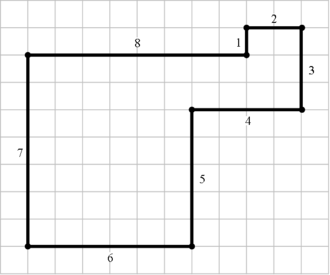Golygon

A golygon is any polygon with all right angles (a rectilinear polygon) whose sides are consecutive integer lengths. Golygons were invented and named by Lee Sallows, and popularized by A.K. Dewdney in a 1990 Scientific American column (Smith).[1] Variations on the definition of golygons involve allowing edges to cross, using sequences of edge lengths other than the consecutive integers, and considering turn angles other than 90°.[2]
In any golygon, all horizontal edges have the same parity as each other, as do all vertical edges. Therefore, the number n of sides must allow the solution of the system of equations
It follows from this that n must be a multiple of 8.
The number of golygons for a given permissible value of n may be computed efficiently using generating functions (sequence A007219 in the OEIS). The number of golygons for permissible values of n is 4, 112, 8432, 909288, etc.[3] Finding the number of solutions that correspond to non-crossing golygons seems to be significantly more difficult.
There is a unique eight-sided golygon (shown in the figure); it can tile the plane by 180-degree rotation using the Conway criterion.
Generalizations
A serial-sided isogon of order n is a closed polygon with a constant angle at each vertex and having consecutive sides of length 1, 2, ..., n units. The polygon may be self-crossing.[4] Golygons are a special case of serial-sided isogons.[5]
The three-dimensional generalization of a golygon is called a golyhedron–a closed simply-connected solid figure confined to the faces of a cubical lattice and having face areas in the sequence 1, 2, ..., n, for some integer n.[6] Golyhedrons have been found with values of n equal to 32, 15, 12, and 11 (the minimum possible).[7]
References
- ↑ Dewdney, A.K. (1990). "An odd journey along even roads leads to home in Golygon City". Scientific American. 263: 118–121.
- ↑ Harry J. Smith. "What is a Golygon?". Archived from the original on 2009-10-27.
- ↑ Weisstein, Eric W. "Golygon". MathWorld.
- ↑ Sallows, Lee (1992). "New pathways in serial isogons". The Mathematical Intelligencer. 14 (2): 55–67. doi:10.1007/BF03025216.
- ↑ Sallows, Lee; Gardner, Martin; Guy, Richard K.; Knuth, Donald (1991). "Serial isogons of 90 degrees". Mathematics Magazine. 64 (5): 315–324. doi:10.2307/2690648. JSTOR 2690648.
- ↑ Golygons and golyhedra
- ↑ Golyhedron update